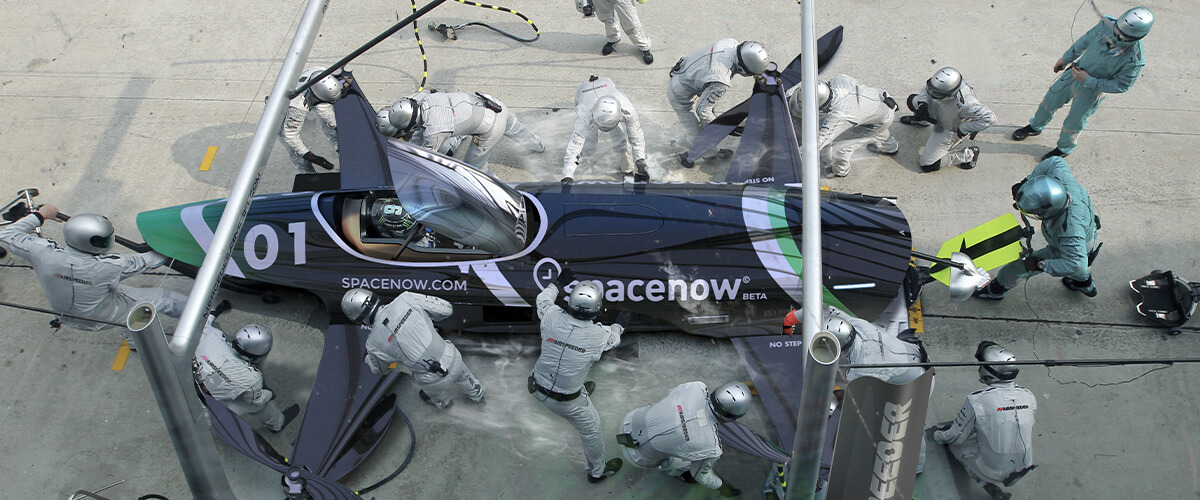Take a racing drone and an F1 car, and put them together. What do you get? Airspeeder of course! Aka: flying-car racing, possibly the coolest sport ever created. And don't worry, I checked the press release date: April 8th not April 1st.
I have spoken about flying cars in the past, but Airspeeder is so insane it might actually work.
What's Airspeeder?
Airspeeder is being marketed as the flying car answer to Formula 1, just more powerful and in the sky! It's the brainchild of South African-born, Australian Entrepreneur, Matt Pearson. The man who gets to live out his childhood fantasy of owning and piloting, a flying car.
I think this is going to be the most watchable sport in the world -- Matt Pearson
The cars themselves are based on octocopter drones but are much larger. They have 8 motors, 8 propellers, and a 500kw battery. This means that they have a better power to weight ratio than an F1 car or a fighter jet. Their predicted top speed is around 200 km/ph (125 mph).

Image credit: Airspeeder
The difference between Airspeeder and drone racing, like MultiGP and The Drone Racing Leauge, is that these will be manned (or womaned) vehicles.
Much like Formula-E, it will be a team sport, the cars will require pit crews and battery changes. Exact details of the race course have not yet been released but, when I spoke to the team, they told me that there would be "low and high flying aspects, with on-site audience viewing". The cars will fly from 5m-100m although they claim that planes can reach heights of 2000m, so maybe the limit will be changed in the future.
What about safety?
With a sport like this safety is an important factor for the team at Alauda Racing. Especially as one of the engineers, Michael Irwan, will be flying the car himself.
The team will be using a technology similar to the FBW (Fly-By-Wire) system used in modern aircraft. This technology replaces manual controls with electric signals sent "by wires". The advantage is a reduction in weight and also the ability to add an automated input such as autopilot or a safety takeover.

Matt Pearson (center forward) and some of his team. It's a tiny team, only 4 Engineers and 2 Designers!
Collision avoidance is also an issue. Alauda Racing plan on employing technologies developed for self-driving vehicles such as Computer Vision (technology that allows computers to "see" and interpret visual information). The technology will enable them to automatically detect potential dangers using cameras, or other sensors and will mean that the vehicles can alert the pilots to potential collisions and possibly even force a safety override. However, at such high speeds, the time taken to perform these calculations will add an additional challenge to the development process.

Image credit: Airspeeder
They have also paid close attention to the body. Much like the crash test performed on production vehicles, the aircraft itself will undergo a series of drop tests from different angles. This will allow the team to ensure maximum safety for the pilots.
The body itself makes use of well-placed crumple zones and break away parts to absorb impact. In all the crash tests so far the core frame has never failed, which is pretty impressive and hopefully reassuring for the budding pilots.
The design started with a sketch and then followed with feedback from the engineers. The CAD model took around a year to create and is still very much a "work in progress" according to Felix Pierron, the team's vehicle and concept designer.
Why race in the air?
Matt Pearson claims that the technology used to drive Airspeeder will eventually filter into the general market, much as is true of motorsport technology. Developments such as ABS braking, dual overhead camshafts, and carbon fiber first started in motorsport and filtered down to the mainstream.
It's easier to build a hovering flying car, what we wanted to do was race. -- Matt Pearson
He also wanted to create a sport that united companies from all over the world. There are fantastic innovations happening in flying car technologies like the Pal-V, announced at the Geneva International Motor Show 2019 and the Audi/Airbus Flying-Taxi project, but does anything really motivate innovation like competition?
What's next?
So far the team has only tested scale models. With every increase in size, they met new challenges. And, as they are real pioneers in their field, they had no one to turn to ask for help. For example, the team need over 120 individual test flights fix issues with how to motor controllers attached to the motors.

Image credit: Airspeeder
In July they will be showcasing their models at the Goodwood Festival of Speed with 3/4 size models. However, these will be controlled remotely. They'll also be displaying a full-size version! You can see footage of the 3/4 sized models flying on their YouTube channel.
They will be testing a full-sized version in the Mojave Desert, in November although exact date is set.
In 2020 they hope to have the first Flying Car Grand Prix. 5 teams 10 pilots and 10 cars will race head to head, at this stage, it seems somewhat ambitious, but here's hoping.
Airspeeder
Airspeeder is the flying car answer to Formula 1. Safety is important, especially as one of the engineers will be flying the car himself. To improve safety they are using technologies found in driverless vehicles and jet planes, as well as crash tests. In July they will be showcasing their models at the Goodwood Festival of Speed. In 2020 the first Flying Car Grand Prix: 5 teams 10 pilots and 10 cars will race head to head.


